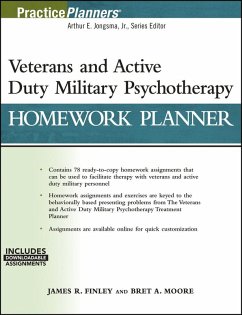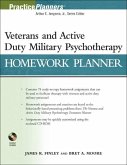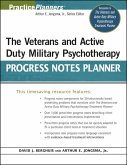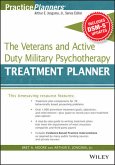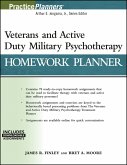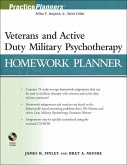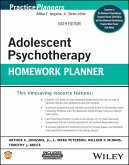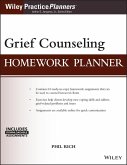Veterans and Active Duty Military Psychotherapy Homework Planner (eBook, ePUB)


Alle Infos zum eBook verschenken

Veterans and Active Duty Military Psychotherapy Homework Planner (eBook, ePUB)
- Format: ePub
- Merkliste
- Auf die Merkliste
- Bewerten Bewerten
- Teilen
- Produkt teilen
- Produkterinnerung
- Produkterinnerung

Hier können Sie sich einloggen

Bitte loggen Sie sich zunächst in Ihr Kundenkonto ein oder registrieren Sie sich bei bücher.de, um das eBook-Abo tolino select nutzen zu können.
The Veterans and Active Duty Military Psychotherapy Homework Planner provides you with an array of ready-to-use, between-session assignments designed to fit virtually every therapeutic mode. This easy-to-use sourcebook features: * 78 ready-to-copy exercises covering the most common issues encountered by veterans and active duty soldiers in therapy, such as anger management, substance abuse and dependence, bereavement, pre-deployment stress, and chronic pain after injury * A quick-reference format--the interactive assignments are grouped by behavioral problems including combat and operational…mehr
- Geräte: eReader
- mit Kopierschutz
- eBook Hilfe
- Größe: 5.72MB
![Veterans and Active Duty Military Psychotherapy Homework Planner (eBook, ePUB) Veterans and Active Duty Military Psychotherapy Homework Planner (eBook, ePUB)]() James R. FinleyVeterans and Active Duty Military Psychotherapy Homework Planner (eBook, ePUB)56,99 €
James R. FinleyVeterans and Active Duty Military Psychotherapy Homework Planner (eBook, ePUB)56,99 €![The Veterans and Active Duty Military Psychotherapy Progress Notes Planner (eBook, ePUB) The Veterans and Active Duty Military Psychotherapy Progress Notes Planner (eBook, ePUB)]() Arthur E. JongsmaThe Veterans and Active Duty Military Psychotherapy Progress Notes Planner (eBook, ePUB)59,99 €
Arthur E. JongsmaThe Veterans and Active Duty Military Psychotherapy Progress Notes Planner (eBook, ePUB)59,99 €![The Veterans and Active Duty Military Psychotherapy Treatment Planner, with DSM-5 Updates (eBook, ePUB) The Veterans and Active Duty Military Psychotherapy Treatment Planner, with DSM-5 Updates (eBook, ePUB)]() Bret A. MooreThe Veterans and Active Duty Military Psychotherapy Treatment Planner, with DSM-5 Updates (eBook, ePUB)59,99 €
Bret A. MooreThe Veterans and Active Duty Military Psychotherapy Treatment Planner, with DSM-5 Updates (eBook, ePUB)59,99 €![Veterans and Active Duty Military Psychotherapy Homework Planner (eBook, PDF) Veterans and Active Duty Military Psychotherapy Homework Planner (eBook, PDF)]() James R. FinleyVeterans and Active Duty Military Psychotherapy Homework Planner (eBook, PDF)59,99 €
James R. FinleyVeterans and Active Duty Military Psychotherapy Homework Planner (eBook, PDF)59,99 €![Veterans and Active Duty Military Psychotherapy Homework Planner (eBook, PDF) Veterans and Active Duty Military Psychotherapy Homework Planner (eBook, PDF)]() James R. FinleyVeterans and Active Duty Military Psychotherapy Homework Planner (eBook, PDF)56,99 €
James R. FinleyVeterans and Active Duty Military Psychotherapy Homework Planner (eBook, PDF)56,99 €![Adolescent Psychotherapy Homework Planner (eBook, ePUB) Adolescent Psychotherapy Homework Planner (eBook, ePUB)]() Arthur E. JongsmaAdolescent Psychotherapy Homework Planner (eBook, ePUB)48,99 €
Arthur E. JongsmaAdolescent Psychotherapy Homework Planner (eBook, ePUB)48,99 €![Grief Counseling Homework Planner (eBook, ePUB) Grief Counseling Homework Planner (eBook, ePUB)]() Phil RichGrief Counseling Homework Planner (eBook, ePUB)59,99 €
Phil RichGrief Counseling Homework Planner (eBook, ePUB)59,99 €-
-
-
Dieser Download kann aus rechtlichen Gründen nur mit Rechnungsadresse in A, B, BG, CY, CZ, D, DK, EW, E, FIN, F, GR, HR, H, IRL, I, LT, L, LR, M, NL, PL, P, R, S, SLO, SK ausgeliefert werden.
- Produktdetails
- Verlag: John Wiley & Sons
- Seitenzahl: 336
- Erscheinungstermin: 27. April 2017
- Englisch
- ISBN-13: 9781119384830
- Artikelnr.: 52560282
- Verlag: John Wiley & Sons
- Seitenzahl: 336
- Erscheinungstermin: 27. April 2017
- Englisch
- ISBN-13: 9781119384830
- Artikelnr.: 52560282
- Herstellerkennzeichnung Die Herstellerinformationen sind derzeit nicht verfügbar.
Preface xv
SECTION I-Adjustment to Killing 1
Exercise I.A Normal Reactions to Killing 2
Exercise I.B When Killing Is Necessary 6
SECTION II-Adjustment to the Military Culture 8
Exercise II.A How Did I Imagine My Life in the Military? 9
Exercise II.B All for One and One for All 12
SECTION III-Amputation, Loss of Mobility, Disfigurement 14
Exercise III.A Mourning and Acceptance 15
Exercise III.B What Makes Me Who I Am? 19
SECTION IV-Anger Management and Domestic Violence 21
Exercise IV.A Anger as a Drug 22
Exercise IV.B Being Who I Want to Be 25
SECTION V-Antisocial Behavior in the Military 28
Exercise V.A What Was I Thinking? 29
Exercise V.B Mentorship and Respect 32
SECTION VI-Anxiety 34
Exercise VI.A Action, Coping Skills, and Acceptance 35
Exercise VI.B Getting Away from Catastrophizing 39
SECTION VII-Attention and Concentration Deficits 41
Exercise VII.A Staying Focused 42
Exercise VII.B Structuring My Life 46
SECTION VIII-Bereavement Due to the Loss of a Comrade 49
Exercise VIII.A Commemorating Lost Friends and Family 50
Exercise VIII.B How Do I Want to Be Remembered? 54
SECTION IX-Borderline Personality 57
Exercise IX.A Am I Comparing My Insides with Other People's Outsides? 58
Exercise IX.B I Can't Believe Everything I Think 61
SECTION X-Brief Reactive Psychotic Episode 64
Exercise X.A Staying in Touch with Reality 65
Exercise X.B Reality Checks 69
SECTION XI-Chronic Pain after Injury 72
Exercise XI.A Alternative Methods for Managing Pain 73
Exercise XI.B Coping with Addiction and Chronic Pain 77
Exercise XI.C Helping Myself by Helping Others 81
SECTION XII-Combat and Operational Stress Reaction 84
Exercise XII.A Normal Reactions in Extreme Situations 85
Exercise XII.B Healthy Ways to Handle Stress Fast 89
SECTION XIII-Conflict with Comrades 92
Exercise XIII.A Communication and Conflict Management Skills 93
Exercise XIII.B Understanding Sources of Conflict 98
SECTION XIV-Depression 101
Exercise XIV.A Challenging Depressive Illusions 102
Exercise XIV.B From Acceptance to Appreciation 106
SECTION XV-Diversity Acceptance 109
Exercise XV.A Different People, Different Strengths 110
Exercise XV.B We're More Alike than We Look:
Seeing Past the Surface 114
SECTION XVI-Financial Difficulties 117
Exercise XVI.A Money Management Skills 118
Exercise XVI.B Spending as a Drug 122
SECTION XVII-Homesickness/Loneliness 125
Exercise XVII.A Making the Best of Wherever I Am 126
Exercise XVII.B This, Too, Shall Pass: Taking It One Day at a Time 130
SECTION XVIII-Insomnia 133
Exercise XVIII.A Why Can't I Sleep? 134
Exercise XVIII.B Sleep Management 138
SECTION XIX-Mild Traumatic Brain Injury 140
Exercise XIX.A Adapting to a Brain Injury 141
Exercise XIX.B Helping My Family and Friends Help Me 144
SECTION XX-Nightmares 147
Exercise XX.A What Are My Dreams Telling Me?
Keeping a Dream Journal 148
Exercise XX.B Avoiding and Coping with Nightmares 151
SECTION XXI-Opioid Dependence 154
Exercise XXI.A Near-Term and Long-Term Effects of Opioid Dependence and
Withdrawal 155
Exercise XXI.B Safe and Healthy Alternatives: Ways to Cope with Pain and
Anxiety without Drugs 159
SECTION XXII-Panic/Agoraphobia 162
Exercise XXII.A Working with Fear 163
Exercise XXII.B Preventing Panic in Myself and Others 167
SECTION XXIII-Parenting Problems Related to Deployment 170
Exercise XXIII.A How Will I Explain This Deployment to My Children? 171
Exercise XXIII.B How Will I Stay in Touch with My Children? 175
SECTION XXIV-Performance-Enhancing Supplement Use 178
Exercise XXIV.A Near-Term and Long-Term Effects of Stimulant Dependence and
Withdrawal 179
Exercise XXIV.B Near-Term and Long-Term Effects of Anabolic Steroid
Dependence and Withdrawal 183
SECTION XXV-Phobia 186
Exercise XXV.A Useful and Useless Fear 187
Exercise XXV.B Understanding and Overcoming Phobias 191
SECTION XXVI-Physiological Stress Response-Acute 194
Exercise XXVI.A Quick Strategies for Coping with Intense Stress Response
195
Exercise XXVI.B Safe and Peaceful Place Meditation 199
SECTION XXVII-Post-Deployment Reintegration Problems 202
Exercise XXVII.A Why Am I Having Trouble Now? 203
Exercise XXVII.B What's Different and How Will I Adapt? 207
SECTION XXVIII-Posttraumatic Stress Disorder (PTSD) 209
Exercise XXVIII.A I Am a Survivor, Not a Victim-PTSD as Lifesaving
Adaptation 210
Exercise XXVIII.B Identifying and Avoiding or Coping with PTSD Triggers 214
SECTION XXIX-Pre-Deployment Stress 217
Exercise XXIX.A Am I Ready for Deployment? 218
Exercise XXIX.B Helping My Family Prepare for My Deployment 222
SECTION XXX-Separation and Divorce 232
Exercise XXX.A Getting Through the Loss of a Relationship 233
Exercise XXX.B Avoiding Rebounds, Replays, and Resentments: Identifying and
Changing Patterns that Aren't Working 237
SECTION XXXI-Sexual Assault by Another Service Member 240
Exercise XXXI.A Taking Care of Myself Physically and Emotionally after a
Sexual Assault 241
Exercise XXXI.B Healing and Claiming My Identity as a Survivor 245
SECTION XXXII-Shift Work Sleep Disorder 248
Exercise XXXII.A Alternative Sleep Scheduling 249
Exercise XXXII.B Establishing a Shift Work Sleep Environment 253
SECTION XXXIII-Social Discomfort 255
Exercise XXXIII.A Getting More Comfortable in Social Situations 256
Exercise XXXIII.B Finding a Social Niche and Friendships 260
SECTION XXXIV-Spiritual and Religious Issues 263
Exercise XXXIV.A Understanding Spirituality 264
Exercise XXXIV.B What Do I Believe In? 268
SECTION XXXV-Substance Abuse/Dependence 271
Exercise XXXV.A What Does Addiction Mean to Me? 272
Exercise XXXV.B Problem Identification 276
Exercise XXXV.C Personal Recovery Planning 279
SECTION XXXVI-Suicidal Ideation 284
Exercise XXXVI.A What Do I Have to Offer to Others? 285
Exercise XXXVI.B Finding Emotional Relief and Support 289
SECTION XXXVII-Survivor's Guilt 292
Exercise XXXVII.A Corresponding with Fallen Friends 293
Exercise XXXVII.B Carrying the Legacy 297
SECTION XXXVIII-Tobacco Use 300
Exercise XXXVIII.A Avoiding Nicotine Relapse Triggers 301
Exercise XXXVIII.B Use of Affirmations for Change 304
Appendix: Additional Assignments for Presenting Problems 307
About the Downloadable Assignments 316
Preface xv
SECTION I-Adjustment to Killing 1
Exercise I.A Normal Reactions to Killing 2
Exercise I.B When Killing Is Necessary 6
SECTION II-Adjustment to the Military Culture 8
Exercise II.A How Did I Imagine My Life in the Military? 9
Exercise II.B All for One and One for All 12
SECTION III-Amputation, Loss of Mobility, Disfigurement 14
Exercise III.A Mourning and Acceptance 15
Exercise III.B What Makes Me Who I Am? 19
SECTION IV-Anger Management and Domestic Violence 21
Exercise IV.A Anger as a Drug 22
Exercise IV.B Being Who I Want to Be 25
SECTION V-Antisocial Behavior in the Military 28
Exercise V.A What Was I Thinking? 29
Exercise V.B Mentorship and Respect 32
SECTION VI-Anxiety 34
Exercise VI.A Action, Coping Skills, and Acceptance 35
Exercise VI.B Getting Away from Catastrophizing 39
SECTION VII-Attention and Concentration Deficits 41
Exercise VII.A Staying Focused 42
Exercise VII.B Structuring My Life 46
SECTION VIII-Bereavement Due to the Loss of a Comrade 49
Exercise VIII.A Commemorating Lost Friends and Family 50
Exercise VIII.B How Do I Want to Be Remembered? 54
SECTION IX-Borderline Personality 57
Exercise IX.A Am I Comparing My Insides with Other People's Outsides? 58
Exercise IX.B I Can't Believe Everything I Think 61
SECTION X-Brief Reactive Psychotic Episode 64
Exercise X.A Staying in Touch with Reality 65
Exercise X.B Reality Checks 69
SECTION XI-Chronic Pain after Injury 72
Exercise XI.A Alternative Methods for Managing Pain 73
Exercise XI.B Coping with Addiction and Chronic Pain 77
Exercise XI.C Helping Myself by Helping Others 81
SECTION XII-Combat and Operational Stress Reaction 84
Exercise XII.A Normal Reactions in Extreme Situations 85
Exercise XII.B Healthy Ways to Handle Stress Fast 89
SECTION XIII-Conflict with Comrades 92
Exercise XIII.A Communication and Conflict Management Skills 93
Exercise XIII.B Understanding Sources of Conflict 98
SECTION XIV-Depression 101
Exercise XIV.A Challenging Depressive Illusions 102
Exercise XIV.B From Acceptance to Appreciation 106
SECTION XV-Diversity Acceptance 109
Exercise XV.A Different People, Different Strengths 110
Exercise XV.B We're More Alike than We Look:
Seeing Past the Surface 114
SECTION XVI-Financial Difficulties 117
Exercise XVI.A Money Management Skills 118
Exercise XVI.B Spending as a Drug 122
SECTION XVII-Homesickness/Loneliness 125
Exercise XVII.A Making the Best of Wherever I Am 126
Exercise XVII.B This, Too, Shall Pass: Taking It One Day at a Time 130
SECTION XVIII-Insomnia 133
Exercise XVIII.A Why Can't I Sleep? 134
Exercise XVIII.B Sleep Management 138
SECTION XIX-Mild Traumatic Brain Injury 140
Exercise XIX.A Adapting to a Brain Injury 141
Exercise XIX.B Helping My Family and Friends Help Me 144
SECTION XX-Nightmares 147
Exercise XX.A What Are My Dreams Telling Me?
Keeping a Dream Journal 148
Exercise XX.B Avoiding and Coping with Nightmares 151
SECTION XXI-Opioid Dependence 154
Exercise XXI.A Near-Term and Long-Term Effects of Opioid Dependence and
Withdrawal 155
Exercise XXI.B Safe and Healthy Alternatives: Ways to Cope with Pain and
Anxiety without Drugs 159
SECTION XXII-Panic/Agoraphobia 162
Exercise XXII.A Working with Fear 163
Exercise XXII.B Preventing Panic in Myself and Others 167
SECTION XXIII-Parenting Problems Related to Deployment 170
Exercise XXIII.A How Will I Explain This Deployment to My Children? 171
Exercise XXIII.B How Will I Stay in Touch with My Children? 175
SECTION XXIV-Performance-Enhancing Supplement Use 178
Exercise XXIV.A Near-Term and Long-Term Effects of Stimulant Dependence and
Withdrawal 179
Exercise XXIV.B Near-Term and Long-Term Effects of Anabolic Steroid
Dependence and Withdrawal 183
SECTION XXV-Phobia 186
Exercise XXV.A Useful and Useless Fear 187
Exercise XXV.B Understanding and Overcoming Phobias 191
SECTION XXVI-Physiological Stress Response-Acute 194
Exercise XXVI.A Quick Strategies for Coping with Intense Stress Response
195
Exercise XXVI.B Safe and Peaceful Place Meditation 199
SECTION XXVII-Post-Deployment Reintegration Problems 202
Exercise XXVII.A Why Am I Having Trouble Now? 203
Exercise XXVII.B What's Different and How Will I Adapt? 207
SECTION XXVIII-Posttraumatic Stress Disorder (PTSD) 209
Exercise XXVIII.A I Am a Survivor, Not a Victim-PTSD as Lifesaving
Adaptation 210
Exercise XXVIII.B Identifying and Avoiding or Coping with PTSD Triggers 214
SECTION XXIX-Pre-Deployment Stress 217
Exercise XXIX.A Am I Ready for Deployment? 218
Exercise XXIX.B Helping My Family Prepare for My Deployment 222
SECTION XXX-Separation and Divorce 232
Exercise XXX.A Getting Through the Loss of a Relationship 233
Exercise XXX.B Avoiding Rebounds, Replays, and Resentments: Identifying and
Changing Patterns that Aren't Working 237
SECTION XXXI-Sexual Assault by Another Service Member 240
Exercise XXXI.A Taking Care of Myself Physically and Emotionally after a
Sexual Assault 241
Exercise XXXI.B Healing and Claiming My Identity as a Survivor 245
SECTION XXXII-Shift Work Sleep Disorder 248
Exercise XXXII.A Alternative Sleep Scheduling 249
Exercise XXXII.B Establishing a Shift Work Sleep Environment 253
SECTION XXXIII-Social Discomfort 255
Exercise XXXIII.A Getting More Comfortable in Social Situations 256
Exercise XXXIII.B Finding a Social Niche and Friendships 260
SECTION XXXIV-Spiritual and Religious Issues 263
Exercise XXXIV.A Understanding Spirituality 264
Exercise XXXIV.B What Do I Believe In? 268
SECTION XXXV-Substance Abuse/Dependence 271
Exercise XXXV.A What Does Addiction Mean to Me? 272
Exercise XXXV.B Problem Identification 276
Exercise XXXV.C Personal Recovery Planning 279
SECTION XXXVI-Suicidal Ideation 284
Exercise XXXVI.A What Do I Have to Offer to Others? 285
Exercise XXXVI.B Finding Emotional Relief and Support 289
SECTION XXXVII-Survivor's Guilt 292
Exercise XXXVII.A Corresponding with Fallen Friends 293
Exercise XXXVII.B Carrying the Legacy 297
SECTION XXXVIII-Tobacco Use 300
Exercise XXXVIII.A Avoiding Nicotine Relapse Triggers 301
Exercise XXXVIII.B Use of Affirmations for Change 304
Appendix: Additional Assignments for Presenting Problems 307
About the Downloadable Assignments 316
